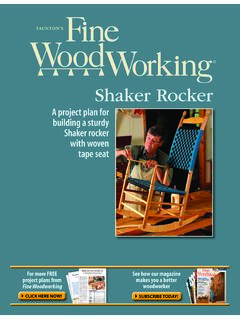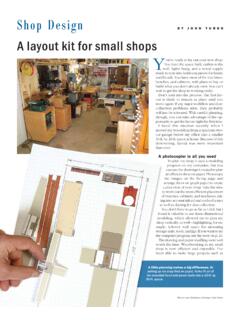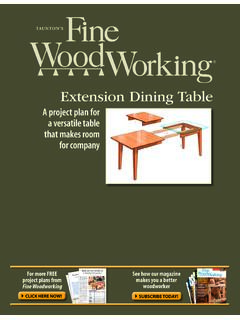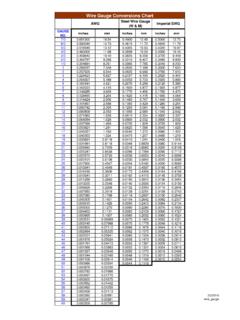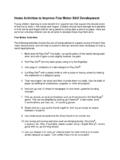Transcription of Round dog holes, Workbench - Fine Woodworking
1 WINTER 2003/2004 TShis latest attempt to design a woodworker s bench is built onthe foundation of the dozens that have graced the pages ofthis publication, starting with Tage Frid s in the fall of 1976(FWW#4). His includes a built-in tool tray, a shoulder vise on theleft, and a tail vise on the right, with a single row of dog holesalong the front apron much different from the bench seen s bench is a classic northern-European design that traces itsroots back centuries before the introduction of electricity. Frid sbench and Frank Klausz s very similar design a few years later(FWW#53) have influenced modern bench builders for decades. Several fine Woodworkingeditors and I recently collaboratedon designing an essential Workbench for today s woodworker, onethat is straightforward to build without compromising perfor-mance.
2 This bench was designed to be a tool more workhorsethan showpiece. We did not include traditional components simplyfor history s sake, and we took advantage of modern also wanted this bench to be a project that most woodworkerscould build using tools found in an average small shop: tablesaw,portable planer, crosscut saw, router, drill press, and hand tools. TheWorkhorse bench combines the best of the old and the newBY LON SCHLEININGANATOMY OF A WORKBENCHThis bench consists of (andconstruction proceeds in this order):a trestle base joined with mortise-and-tenons; a thick top laminatedfrom boards set on edge; and frontand end vises, both with wood jaws. Roundover on trestlemembers and vise jaws, 21 8-in. radiusDowels, 7 16in.
3 Dia.,chamfered on tipStretchers, 13 4in. thick by 4 by 505 8in. long overall(includes an extra 1 16in. on eachtenon for trimming after wedging)Tenons, 1 in. thickby 31 4in. wide by31 16in. longSquare dog holes, made to fitmetal dogs, tilting 3 towardend vise and 6 in. , arealigned with dogs in end apron,13 4in. thick by6 in. wide by75 in. longFront vise jaw, 3 by 6 in. wide by18 in. long; inside facebeveled 1 8in. top tobottomRound dog holes, 3 , are aligned with dogholes in front vise WOODWORKINGD rawings: Bob La PointeTThe Essential Wo r k b e n c hTOOLS & SHOPS 200439 Trestle top member,3 in. thick by 3 by 253 4in. longTrestle feet, 31 2in. thick by31 2in. wide by 28 in. longTrestle legs, 3 in. thickby 3 in. wide by 311 , including tenonsLower tenons, 11 by 21 4in.
4 Wideby 21 2in. longUpper tenons, 11 2in. thick by21 4in. wide by 31 16in. long(includes an extra 1 16in. fortrimming after wedging)Wedges, 5 End caps, 13 4in. thick by6 in. wide by 273 4in. long,are glued to the top at thefront and barrel-bolted atthe center and dovetail iscentered on slab, 21 by 26 by 733 overallTongue, 3 4in. thickby 11 16in. longEnd vise jaw, 3 by 65 8in. wideby 273 4in. long, arebeveled 1 8in. top tobottom on the OF SUPPLYPREMADE BENCHTOP SLABSG rizzly Industrial800-523-4777; Valley Tools800-871-8158; ; FRONT VISE WoodcraftVERITAS TWIN-SCREW VISELee Valley ToolsSTEEL BENCHDOGS (SQUARE)Highland Hardware800-241-6748; BENCHDOGSLee Valley Tools1 Woodworking only heavy-duty tool I used was a 3-hp tablesaw.
5 Ripping lots of 8/4maple puts a strain on even a large saw, so use a clean, sharp blade. A durable Workbench requires beefy partsAvid woodworkers themselves, FWWeditors regularly visit shopsacross the country, and they see a wide array of Workbench con-figurations. Like all woodworkers, they know what they like anddon t like. In the end we all compromised a bit, but we reached asolid consensus. My own involvement arose from having spent thelast year researching and writing a book on workbenches (look forit in the fall of 2004 from The Taunton Press). I was commissionedto finalize this design, write the article, and build the bench. A thick, solid top We decided on an overall size of 28 in.
6 Wideby 6 ft. long. Add a few inches for vise jaws, and it s a nice, big editors thought 2 in. in top thickness would be plenty, with ex-tra thickness at the edges, but I made this top 21 2in. thick becauseit wasn t much more difficult to mill and laminate thicker , if you start with a premade bench slab, the standard13 4-in. thickness offers plenty of mass and solidity for serious hand-tool use, especially after adding the thicker apron and end caps. Gluing up the slab allowed me to machine the square dog holesbefore the pieces were assembled. Round dog holes might be abetter option for a premade slab because square ones are best cutwhile the top slab is in , rigid base I wanted the benchtop and base to be nicelyproportioned.
7 Many benches I ve seen look like top-heavy slabson spindly legs. Also, it was important that the bench not rack orskid across the floor under heavy handplaning. A thick trestle base,A jig makes easy work of mortisesThere are 16 mortises(and tenons) in the basebut only two differentsizes. Make two mortis-ing jigs to speed up lay-out and guide the jig is made from threeblocks glued and screwedtogether, with a fenceattached on each side tohug the and lay out the the jig, this job should go out most of the waste. Thelayout lines will guide you. For theblind mortises, set the drillpress s depth out the rest with chisels. Re-move most of the material with a 1 before switching to a wider jig will guide the chisels feet are pinned to the legs.
8 Start by drilling the dowel holes in the feet, dry-fitting the joints, and transferring (left)the dowel- hole locations to the tenons. Then use a center punch (center) to offset those locations slightly on the tenons,creating the draw effect. Last, apply glue to all surfaces, assemble the joint, and drive home the dowels (right).BLIND MORTISE-AND-TENONS ARE PINNED FOR STRENGTHThe deep mortise-and-tenon joints areeither draw-pinnedor wedged to ensuredecades of , assemble thetrestles, then addthe long stretchersto complete & SHOPS 200441 Photos: Asa Christianajoined with pinned or wedged mortise-and-tenons, guarantees sta-bility. I laminated 8/4 lumber to make these thick members (andthe top slab) because 8/4 is readily available in most regions.
9 Splitting the stretchers, two high and two low, leaves a perfectopening for a future cabinet with drawers. The traditional single,wide stretcher would have saved some time, but it also wouldhave blocked this natural storage area. Innovative vises Hundreds of woodworkers probably wouldsay they could not get through a day without a conventional tailvise, which is designed primarily for clamping things flat on thebenchtop between dogs. Others would say the same for a shoul-der vise, which offers the capability of clamping workpieces be-tween its jaws without interference from guide bars or screws. TheVeritas Twin-Screw Vise incorporates some of the capabilities ofboth types, allowing long boards or large panels to be clampedwith benchdogs as well as clamping an upright board up to 15 for operations such as dovetailing.
10 The two screws are con-nected with a chain, preventing the jaws from racking no matterwhere a workpiece is located or which row of dog holes is used. I ve always loved the look and performance of thick wooden jawson a front vise but found it tedious to crank the long screw in andout constantly. I was tempted to install a cast-iron, quick-actionRecord-style vise, until I found a German-made quick-action visescrew and guide bars at Woodcraft. That allowed me to design awooden front jaw to match the one I made for the Veritas end viseWedge the top members and stretchers. The slots in the tenons areangled 5 to match the wedge angle. A hole is drilled at the base ofeach slot to prevent splitting.
